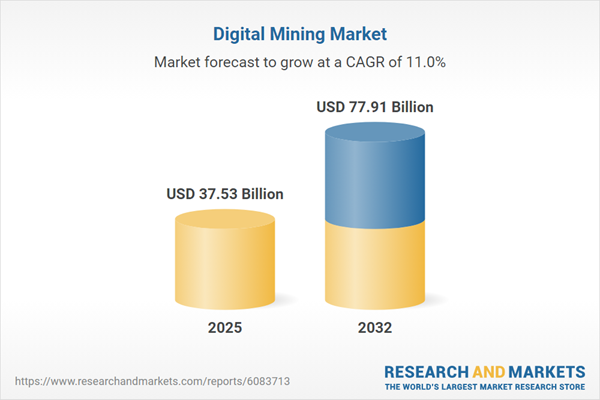Speak directly to the analyst to clarify any post sales queries you may have.
The digital mining market is experiencing rapid transformation led by the convergence of automation, analytics, and resilient operational strategies. Senior leaders must now evaluate how these shifting digital trends drive operational efficiency, regulatory compliance, and sustainable competitiveness in an evolving global landscape.
Market Snapshot: Digital Mining Market Growth and Outlook
The Digital Mining Market expanded from USD 33.77 billion in 2024 to USD 37.53 billion in 2025 and is expected to achieve a CAGR of 11.01%, reaching USD 77.91 billion by 2032. This growth trajectory is propelled by the integration of advanced sensor networks, edge computing, and real-time analytics across the mining sector. As regulatory and environmental requirements intensify, operators are implementing digital platforms to enhance safety, streamline asset performance, and strengthen process oversight. The primary keyword—digital mining market—is increasingly shaping leadership agendas as enterprises adapt to the fast-paced technology landscape.
Scope & Segmentation Framework
This research provides an executive-level breakdown of the digital mining market, supporting targeted strategy, investment, and technology alignment across diverse operational contexts. The segmentation highlights how each area impacts value realization and operational improvement across mining organizations worldwide.
- Component: Hardware such as data acquisition systems, networking equipment, and sensors form the backbone of data-driven decision processes. Services include consulting, support and maintenance, as well as system integration tailored for both on-site and remote needs. Software is central to enabling analytics platforms—spanning predictive and real-time uses—control applications, and visualization tools that turn raw data into operational insights.
- Technology: Both cloud-based solutions (covering hybrid, private, and public cloud configurations) and on-premises systems (using local infrastructure) are leveraged, depending on operational complexity and regional regulatory demands. These architectures offer varying degrees of flexibility, security, and scalability—addressing distinct risk, compliance, and performance requirements.
- Application: Key uses include asset management for monitoring equipment and tracking inventory, automation and control including process and robotic systems, data analytics (descriptive, predictive, and prescriptive), and advanced safety solutions like environmental monitoring and workforce safety systems. Each supports improved performance, reliability, and risk mitigation.
- End User: Mining organizations in coal, metals, and minerals sectors face unique asset challenges and compliance mandates, driving tailored technology adoption to optimize value across these distinct segments.
- Geography: Comprehensive coverage extends across the Americas, Europe, Middle East & Africa, and Asia-Pacific. The research offers country-level perspectives to inform region-specific investment and technology pathways, recognizing local regulations, infrastructure maturity, and supply chain factors.
- Key Companies: The analysis includes Bitmain Technologies Ltd., Shenzhen MicroBT Mining Technology Co., Ltd., Canaan Inc., Ebang International Holdings Inc., Innosilicon Technology Co., Ltd., Bitfury Group Ltd., GMO Internet, Inc., Shenzhen StrongU Technology Co., Ltd., Halong Mining Ltd., and Goldshell Technology Co., Ltd.—organizations driving innovation, supply chain diversity, and best practices throughout the sector.
Key Takeaways: Strategic Insights for Executive Decision-Makers
- Integrated, data-driven operational models are now replacing legacy automation pilots, placing renewed focus on seamless asset visibility, regulatory alignment, and workforce protection.
- The evolution of edge computing and resilient digital networks enables continuous monitoring, predictive maintenance, and agile response across distributed mine sites.
- AI-driven analytics are embedded within operational workflows, enabling proactive equipment maintenance and informed management decisions, which reduces manual interventions and downtime.
- Procurement evolves with a drive for modular, software-centric frameworks. These frameworks reduce reliance on imported devices and boost in-region resilience and bespoke adaptation.
- Governance approaches increasingly prioritize cybersecurity, data ownership, and the ethical use of AI, directly supporting risk management in digital adoption.
- Elevated workforce skills and cross-unit collaboration are essential for transitioning from pilot projects to enterprise-wide deployment, unlocking greater returns from digital investments.
Tariff Impact on Supply Chain and Technology Choices
Shifts in tariff policies following 2025 require mining enterprises to reassess procurement and supply chain strategies. Cost structures, lead times, and vendor landscapes are evolving, motivating stronger local supplier development and diversified sourcing. Modular and software-defined technology stacks now support greater adaptability, reducing exposure to cross-border risks while allowing remote integration. This approach sustains technology momentum and business continuity amidst ongoing trade and policy changes.
Methodology & Data Sources
This report synthesizes a mixed-methods approach, including executive interviews, technical literature review, and scenario-based analysis. Input was gathered from operational leaders, system integrators, vendor briefings, engineering papers, and regulatory bodies. The research ensures robust validation by cross-referencing findings and drawing on practical field experience, establishing a reliable foundation for strategic recommendations.
Why This Report Matters
- Empowers executive teams to effectively prioritize investments in digital mining, align technology strategies with measurable business outcomes, and smooth adoption risk.
- Delivers an actionable segmentation model, aiding focused procurement, targeted partnerships, and comprehensive digital transformation planning.
- Equips leaders with actionable insights into evolving regional trends and policy impacts, fostering resilient and adaptive mining operations in a dynamic market.
Conclusion
Digital transformation is a strategic priority in mining, shaped by new technologies, evolving governance, and regional dynamics. Aligning technology deployment, workforce readiness, and operational controls is vital to secure sustainable advantage.
Table of Contents
3. Executive Summary
4. Market Overview
7. Cumulative Impact of Artificial Intelligence 2025
Companies Mentioned
The companies profiled in this Digital Mining market report include:- Bitmain Technologies Ltd.
- Shenzhen MicroBT Mining Technology Co., Ltd.
- Canaan Inc.
- Ebang International Holdings Inc.
- Innosilicon Technology Co., Ltd.
- Bitfury Group Ltd.
- GMO Internet, Inc.
- Shenzhen StrongU Technology Co., Ltd.
- Halong Mining Ltd.
- Goldshell Technology Co., Ltd.
Table Information
| Report Attribute | Details |
|---|---|
| No. of Pages | 186 |
| Published | November 2025 |
| Forecast Period | 2025 - 2032 |
| Estimated Market Value ( USD | $ 37.53 Billion |
| Forecasted Market Value ( USD | $ 77.91 Billion |
| Compound Annual Growth Rate | 11.0% |
| Regions Covered | Global |
| No. of Companies Mentioned | 11 |









